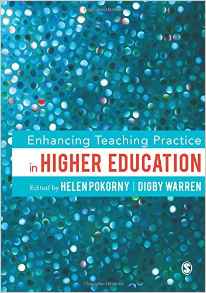In Enhancing Teaching Practice in Higher Education, editors Helen Pokorny and Digby Warren bring together contributors to explore research, theory, models and frameworks for enhancing HE teaching practice, covering topics including course design, assessment and student engagement. John Cullen welcomes this volume for providing vital practical guidance, support and encouragement to Higher Education teachers at all stages of their careers.
Enhancing Teaching Practice in Higher Education. Helen Pokorny and Digby Warren (eds). Sage. 2016.
Find this book (affiliate link): ![]()
 The experience of being a university student, which often attracts us to this profession, is very different to that of being a university teacher. Non-academics rarely see the impact of a growing set of expectations that are placed on teachers, and often the life of an academic is imagined as being solely concerned with abstract intellectual pursuits. Michel Houellebecq’s novel, Submission, for example, presents a picture of a literature professor who, until the disruption caused by significant social change, appears to have a stress-free existence focused on teaching and writing. Houellebecq has pointed out that this characterisation is a complete ‘imagining’. It is a life that is unrecognisable to academics in the contemporary world.
The experience of being a university student, which often attracts us to this profession, is very different to that of being a university teacher. Non-academics rarely see the impact of a growing set of expectations that are placed on teachers, and often the life of an academic is imagined as being solely concerned with abstract intellectual pursuits. Michel Houellebecq’s novel, Submission, for example, presents a picture of a literature professor who, until the disruption caused by significant social change, appears to have a stress-free existence focused on teaching and writing. Houellebecq has pointed out that this characterisation is a complete ‘imagining’. It is a life that is unrecognisable to academics in the contemporary world.
The essential difference between university academics and other post-secondary educators is that we engage in four key activities: (1) teaching; (2) researching; (3) engaging with our communities of practice (in both the broadest and narrowest senses); and (4) performing service to our departmental, organisational and professional communities. This is not to say that non-university academics don’t also do all these, but universities are research-centric in order to ensure that our students benefit from being taught by those who have dedicated their lives to contributing to and developing the fields of knowledge that their students learn.
Being appointed to a position or advancing in one’s academic career depends on demonstrating success and progress in developing one’s teaching identity. The importance of the teaching element of academic life is often downplayed in favour of research. One sometimes hears of academics who decide to focus entirely on becoming a research ‘rockstar’ by choosing to ignore the teaching aspect of their work. However, I don’t think anyone working in Higher Education encounters such mythical creatures too often. The reason why is obvious: teaching is central to what we do, and lecturers and professors who do not respect their students’ need for quality, research-led teaching and assessment soon find that professional life can become quite difficult!
People don’t become academics for an easy life, fame or money. We have been attracted to our fields of work out of a deep interest and passion for the way that our chosen fields can change lives. The content and lecturing style that inspired us as students will not automatically capture the imaginations of another generation. Although the teaching element of our academic identity is vitally important, we are less resourced for developing it and often rely on colleagues or Continuing Professional Development (CPD) programmes to help us along the way. For example, the Chartered Association of Business School’s current journal quality ranking guide only gives one journal in the field of ‘management development and education’ a ranking of 4, while 23 in the field of ‘economics, econometrics and statistics’ receive this (and six of these are ranked as 4* journals). One could argue that the latter are more ‘central’ to what business schools teach, but aren’t students also key to what business schools do?

Enhancing Teaching Practice in Higher Education, edited by Helen Pokorny and Digby Warren, is a text that all lecturers and professors will find useful. It is heavily UK-centric in how it discusses policy and legislative developments, but given that similar ‘swerves’ (such as rankings, massification, marketisation, etc) are taking place at a global level, this should not deter readers. I work in a university in Ireland where the funding allocation model is different to Britain, and the practical guidance provided in Enhancing Teaching Practice in Higher Education is very useful.
The contributors to the chapters in Enhancing Teaching Practice in Higher Education map out the current state of play in relation to topics with which academics grapple throughout their careers: course and learning design and evaluation; leading and managing learning environments; assessment; blended learning; student engagement; student diversity; engaging with academic writing; supervision; workplace/professional learning; and professional development. This text is not just for the novice lecturer: I’ve been working in academia for nearly a decade and a half, and reading it provided an opportunity to reflect on where my teaching is now and how it can be enhanced. Just by reading this list, I anticipate that many practising lecturers can imagine which one they will rush to first for new ideas and inspiration!
Nearly a decade ago, I was attending an in-service CPD programme which was being delivered by an academic who had left the university he had worked in (outside Ireland) to work in a private practice. During a break I asked him about his decision, and he discussed the advantages and disadvantages of life outside the university. He said that the best thing was that he would never have to grade another term paper again! For me, assessment is what makes teaching in Higher Education different. Whenever challenges to the university model are proposed, they do not deliver the encouragement and individual development that are afforded through well-designed assessment strategies.
In my opinion, assessment is where we can most influence the formation of the intellectual abilities of students through the various modes of feedback and encouragement we can provide to students. Assessment is not emphasised in the same way as the student’s experience of teaching on most course evaluations. This is a pity as it is the place where opportunities for individual, impactful learning often take place. This is a concept which extends into related chapters on student engagement and academic writing. The chapter on academic writing, for example, explores the various difficulties and opportunities that exist in relation to assisting students in understanding written assessment as a real opportunity to develop intellectually. I explored this in research (2011), which demonstrated a strong correlation between the quality of writing and the rigour applied to critical thinking and analysis by students.
Throughout Enhancing Teaching Practice in Higher Education, advice is provided through vignettes, lists, cases and suggestions for practice, underlining its practical orientation. If this were a more voluminous text, it probably would not function as well in this practice-based regard. The chapter on professional development at the end of the text points out that being a teacher, much like being a student, is a process that, when engaged with, leads to ongoing improvement. This chapter emphasises the importance of one’s immediate teaching community in supporting and resourcing each other as teachers. Student numbers rise, academic workloads increase, pressure to be research- and service-active grows and the impact of these strains has only just begun to be recognised. Responding to a research lacuna on the emotional impact of the experience of teaching in universities, J. Watts and N. Robertson’s (2011) systematic review of the literature on burnout amongst teaching academics found that exposure to high student numbers was negatively impacting on the health and professional performance of lecturers. Jennifer Bright, Rebecca Eliaho and Pokorny’s final chapter underlines the importance of being part of a supportive department community where mentoring, supportive peer-review, accessing the Scholarship of Teaching & Learning and mindfulness all have a role to play. Texts such as Enhancing Teaching Practice in Higher Education also have a role to play in providing support and encouragement to Higher Education teachers at all stages of their careers.
Note: This review gives the views of the author, and not the position of the LSE Review of Books blog, or of the London School of Economics. The LSE RB blog may receive a small commission if you choose to make a purchase through the above Amazon affiliate link. This is entirely independent of the coverage of the book on LSE Review of Books.
Image Credit: Image by StartupStockPhotos from Pixabay.








1 Comments